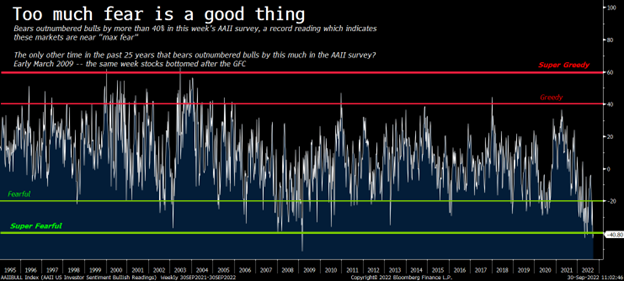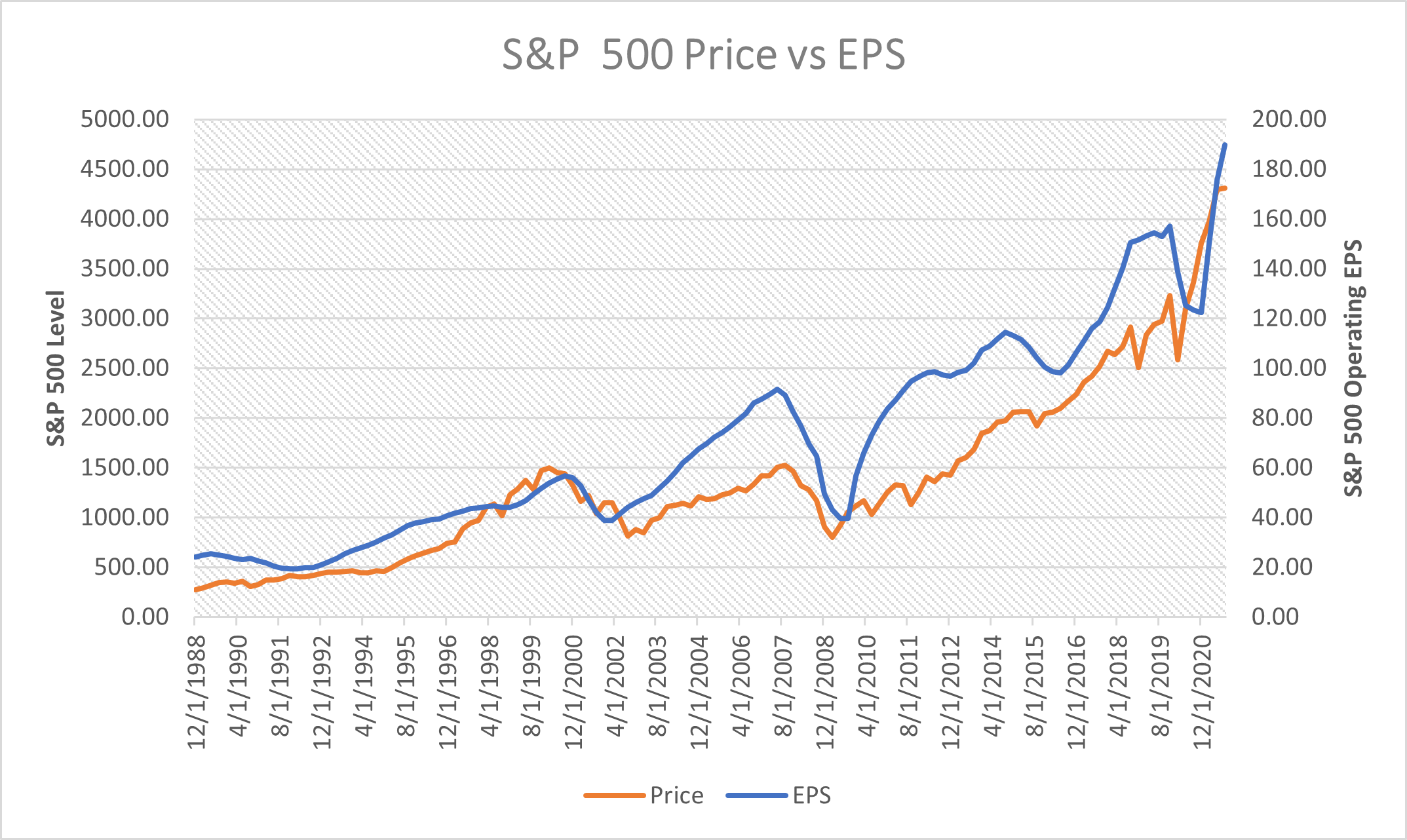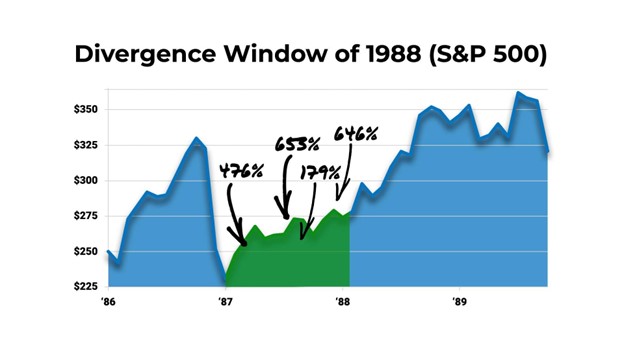- For two weeks in a row, the percentage of bearish investors in America has outnumbered the percentage of bullish investors by more than 40%. The last time this happened was early March 2009 – the exact same week stocks bottomed after the 2008 financial crisis!
- My team and I have discovered a rare stock market phenomenon that occurs about once every 10 years, and it consistently represents the best buying opportunities in U.S. stock market history.
- Every time these divergences emerge, they turn into generational buying opportunities. Stock prices “snap back” to fundamental growth trends, and investors who bought the dip see their returns rocket.
- Because these opportunities emerge out of fear in the markets – and because we’ve reached peak fear – we’ve concluded that this ultra-rare investment opportunity is rapidly closing shut.
It’s been a crazy year in the markets, huh? But what if I told you that all this craziness is actually creating the money-making opportunity of the century?
You’d be skeptical. And that’s fine. Just don’t disregard me because I have a ton of data to prove that claim. Today, we sit on the cusp of arguably the biggest investment opportunity in the stock market… ever.
Yes, I’m aware of all the problems the world is facing today. Decades-high inflation. A U.S. Federal Reserve embarking on the most aggressive rate-hiking cycle in over 40 years. A war in Europe for the first time since World War II. The highest gas prices and grocery prices in decades. The biggest stock market crash since 2008.
Talk about unusual, volatile, scary.
Against that backdrop, I wouldn’t blame you for wanting to run for the hills and take cover from the storm. But the great Warren Buffett once said that it is often best to be greedy when others are fearful.
Everyone’s fearful right now.
The American Association of Individual Investors weekly survey has found that for two weeks in a row, the percentage of bearish investors in America has outnumbered the percentage of bullish investors by more than 40%. That’s an unusually high number which marks “peak fear.” Indeed, the net bull ratio has been this low only once before, in early March 2009 – the exact same week stocks bottomed after the 2008 financial crisis!
Let that sink in for a moment…
There’s nothing but fear out there. Buffett would tell us to get greedy here. But should we heed those words of advice?
Absolutely.
Fear Can Be a Good Thing?
Over the past several months, my team and I have been studying the intricacies of stock market crashes throughout the history of modern capitalism – and we discovered something amazing.
Specifically, we’ve discovered a rare stock market phenomenon that occurs about once every 10 years. And it consistently represents the best buying opportunities in U.S. stock market history.
More than that, we figured out how to quantitatively identify this phenomenon. Yes, we have engineered a way to take advantage of it for massive profits.
Well, folks, guess what’s happening right now?
This ultra-rare stock market phenomenon has emerged. And our models are flashing bright “Buy” signals.
I know. That may sound pretty counterintuitive, considering what’s going on in the market right now.
But I’m staking my career on this claim – because it’s really not an opinion. It’s a fact. Backed by data, history, statistics and mathematics. Backed by the biggest market phenomenon in history.
So, I repeat: We stand on the cusp of an opportunity of a lifetime.
By now, you’re probably asking: OK, Luke, you have my attention…but where’s the proof?
Glad you asked because I have lots of that. Let’s take a deep look.
Stock Prices Follow Fundamentals
To understand the unique phenomenon my team and I have identified, we need to first understand the behavior patterns of stocks.
In the short term, stocks are driven by myriad factors. These include geopolitics, interest rate, inflation, elections, recession fears, and so on.
Big picture, however, stocks are driven by one thing and one thing only: fundamentals.
That is, at the end of the day, revenues and earnings drive stock prices. If a company’s revenues and earnings trend upward over time, then the company’s stock price will follow suit. Conversely, if a company’s revenues and earnings trend downward over time, then the company’s stock price will drop.
That may sound like an oversimplification. But, honestly, it’s not.
Just look at the following chart. It graphs the earnings per share of the S&P 500 (the blue line) alongside the price of the S&P 500 (the orange line) from 1988 to 2022.
As you can see, the blue line (earnings per share) lines up almost perfectly with the orange line (price). The two could not be more strongly correlated. Indeed, the mathematical correlation between the two is 0.93. That’s incredibly strong. A perfect correlation is 1. A perfect anti-correlation is -1.
Therefore, the historical correlation between earnings and stock prices is about as perfectly correlated as anything gets in the real world.
In other words, you can forget the Fed. You can forget inflation and geopolitics. You can forget trade wars, recessions, depressions, and financial crises.
We’ve seen all of that over the past 35 years – and yet, through it all, the correlation between earnings and stock prices never broke or even faltered at all.
At the end of the day, earnings drive stock prices. History is crystal clear on that. In fact, history is as clear on that as it is on anything, mathematically speaking.
The phenomenon my team and I have identified has to do with this correlation. In fact, it has to do with a “break” in this correlation – a break that historically only arises when recession fears are peaking and has produced the greatest stock market buying opportunities in history.
Great Divergence Creates Great Opportunities
Every once in a while – specifically, about once a decade – earnings and revenues temporarily stop driving stock prices.
We call this anomaly a “divergence.”
During these divergences, companies continue to see their revenues and earnings rise. But due to some macroeconomic fears, their stock prices will temporarily collapse. The result is that a company’s stock price diverges from its fundamental growth trend.
Every time these rare divergences emerge, they turn into generational buying opportunities. Stock prices “snap back” to fundamental growth trends, and investors who bought the dip see their returns rocket.
This has happened time and time again, like clockwork, throughout the market’s history.
It happened in the late 1980s during the Savings & Loans crisis. High-quality growth companies – like Microsoft (MSFT) – saw their stock prices collapse while revenues and earnings kept rising. Investors who capitalized on this divergence doubled their money in a year and scored a jaw-dropping ~40,000% returns (on average) in the long run.
And it happened in the early 2000s after the dot-com crash. High-quality growth companies – like Amazon (AMZN) – saw their stock prices plunge. But their revenues and earnings kept rising. Investors who capitalized on this divergence more than doubled their money in a year and scored more than 20,000% returns in the long run.
It happened again in 2008 during the Great Financial Crisis. High-quality growth companies – like Salesforce (CRM) – saw their stock prices collapse. But their revenues and earnings kept rising. Investors who capitalized on this divergence almost tripled their money in a year and hit 10X returns in just five years.
This is the most profitable repeating pattern in stock market history. And it’s happening again right now for the first time in 14 years.
The Final Word on Divergence
My team and I understand that market volatility always creates market opportunity.
So, amid the market’s wild gyrations of 2022, we’ve made it our top priority to research market volatility and develop a stock-picking strategy to make tons of money during choppy markets.
That led us to making the biggest discovery in InvestorPlace history: the existence of rare divergence windows.
These divergence windows only appear about once a decade, amid peak market volatility. They open for very brief moments in time and only for certain stocks. But if you capitalize on them – by buying the right stocks at exactly the right moment – you can make a lot of money while everyone else is struggling to survive in a choppy market.
More than that, these divergence windows give you a real shot at turning $10,000 investments into multi-million-dollar paydays.
The more we researched these divergence windows, the more excited we became.
But here’s the most important part: Because these opportunities emerge out of fear in the markets – and because we’ve reached peak fear – my team and I have concluded that this ultra-rare investment opportunity is rapidly closing shut.
This is your final chance to capitalize on what could be the biggest investment opportunity of your life.
That’s why we’re calling this month the “Zero Hour.” It’s your final opportunity to capitalize on the 2022 divergence.
To help you do that, we’ve put together an emergency broadcast – unsurprisingly dubbed the Zero Hour – to walk you through this enormous investment opportunity. We will go LIVE with that broadcast this Thursday afternoon, at 4 p.m. EST.
In it, I’ll unveil my No. 1 “late-stage” divergence stock to buy right now – for free. This is a stock that could easily soar hundreds of percent over the next year alone!
More than that, I’ll even give viewers the chance to access a brand-new, never-before-seen portfolio of divergence stocks set to soar over the next year.
This is certainly a broadcast you don’t want to miss.
Published First on InvestorPlace. Read Here.
Inner Image Credit: Provided by the Author; Thank you!
Featured Image Credit: Photo by Kampus Production; Pexels; Thank you!
The post How Investors Make Millions Amid Volatility appeared first on ReadWrite.




